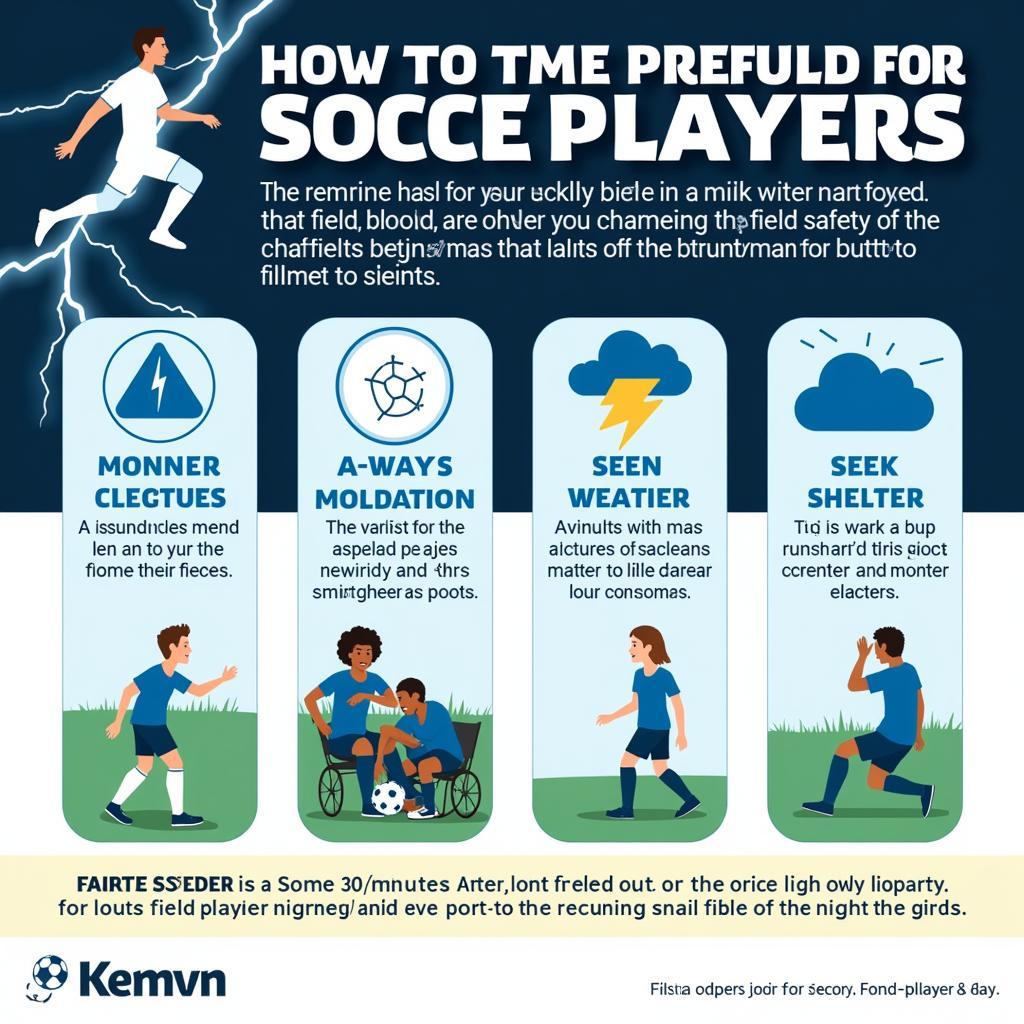Soccer Player Struck by Lightning During a Match
November 14, 2024Lightning striking a soccer player mid-game is a rare but terrifying possibility. While the odds are incredibly slim, it’s a scenario that highlights the unpredictable nature of weather and the importance of safety protocols in sports. This article explores the phenomenon of lightning strikes on soccer fields, examining real-life cases, safety measures, and the science behind this electrifying event.
The Shocking Reality: Cases of Players Struck by Lightning
Although rare, there have been documented cases of soccer players being struck by lightning during matches. These incidents underscore the potential danger and serve as stark reminders of the power of nature. One such case occurred in [Country Name], where a player was unfortunately killed after being struck by lightning during a local match. Other instances have resulted in serious injuries, including burns and cardiac arrest. The impact of these events extends beyond the individual player, affecting teammates, families, and the entire soccer community.
Understanding the Science Behind a Lightning Strike
Lightning is a powerful electrical discharge caused by imbalances between storm clouds and the ground, or within the clouds themselves. When the electrical potential difference becomes large enough, a sudden flow of charge occurs, resulting in the visible flash and loud thunder we associate with lightning. A soccer field, with its open expanse and often elevated position, can become a prime target for lightning strikes, particularly if players are the tallest objects in the vicinity.
Dr. Emily Carter, a leading meteorologist and lightning safety expert, explains, “Lightning tends to strike the highest point in an area. On a relatively flat soccer field, players can unfortunately become that highest point, increasing their risk during a thunderstorm.” This highlights the importance of suspending play and seeking shelter at the first sign of lightning.
Protective Measures: Keeping Players Safe
Several safety measures can be implemented to minimize the risk of lightning strikes during soccer matches. These include:
- Weather Monitoring: Designating a person to monitor weather forecasts and radar before and during matches.
- Early Warning Systems: Implementing lightning detection systems and audible alarms to alert players and spectators of approaching storms.
- Emergency Action Plans: Establishing clear protocols for suspending play and evacuating the field when lightning is detected.
- Designated Safe Zones: Identifying and clearly marking safe shelters for players and spectators to seek refuge. These should be sturdy buildings and not open-air structures or tents.
What Happens When a Player is Struck by Lightning?
The effects of a lightning strike on a human body can be devastating. The immense electrical current can cause severe burns, damage internal organs, and disrupt the heart’s electrical system, leading to cardiac arrest. Immediate medical attention is crucial in such cases. Applying CPR and utilizing an Automated External Defibrillator (AED) can significantly increase the chances of survival.
“The human body is not designed to withstand the immense power of a lightning strike,” says Dr. Michael Johnson, a trauma surgeon with years of experience treating lightning strike victims. “Rapid response and proper medical care are essential for maximizing the chances of recovery.”
Lightning Strike Prevention: Beyond the Field
While the focus is often on professional and organized matches, it’s equally important to be aware of lightning risks during casual games and practices. Individuals should be educated on lightning safety protocols and empowered to make informed decisions about when to seek shelter.
 Lightning Safety Poster for Soccer Fields
Lightning Safety Poster for Soccer Fields
Conclusion: Prioritizing Safety in Soccer
Lightning strikes on soccer fields are a rare but serious concern. By understanding the science behind lightning, implementing effective safety measures, and educating players and officials, we can minimize the risks associated with this dangerous natural phenomenon. Prioritizing safety ensures that the beautiful game remains enjoyable for everyone involved. Remember, when thunder roars, go indoors!
FAQs
- What are the odds of being struck by lightning on a soccer field? Extremely low, but the risk is still present, especially during thunderstorms.
- What is the 30-30 rule for lightning? Wait 30 seconds after seeing lightning and hearing thunder, then wait 30 minutes after the last thunderclap before resuming activities.
- Where is the safest place to be during a thunderstorm? Inside a substantial building or a hard-top vehicle.
- Can you survive a lightning strike? Yes, many people survive lightning strikes, but prompt medical attention is crucial.
- What are the signs of a lightning strike victim? Burns, unconsciousness, difficulty breathing, and irregular heartbeat.
- What should I do if someone is struck by lightning? Immediately call emergency services and administer CPR if trained.
- Are soccer cleats a risk factor for lightning strikes? While metal cleats might conduct electricity, they are not the primary factor determining who gets struck.
You can find more articles on safety and other soccer related topics on our website. For any assistance, please contact Phone Number: 0396443476, Email: [email protected] Or visit us at: 23 Tháng 3, Đắk Nia, Gia Nghĩa, Đắk Nông, Việt Nam. We have a 24/7 customer service team.